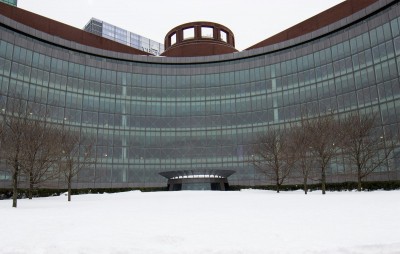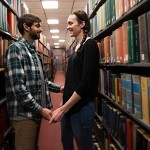The Tsarnaev trial continued Monday at the John Joseph Moakley United States Courthouse with the testimony of three Watertown policemen recounting their experiences from the night of April 18, 2013.

Dzhokhar Tsarnaev, 21, is charged with 30 federal counts, to which he has pled not guilty. He allegedly placed two bombs at the Boston Marathon finish line in 2013, killing three and injuring more than 260.
Before the officers’ testimony, jurors in the case were brought to an undisclosed location in South Boston for about 30 minutes to view the boat in which Tsarnaev allegedly hid from law enforcement after the April 18, 2013, shootout in Watertown. The boat, Slipaway II, was placed under three large white tents, and alongside the jurors was suspect Dzhokhar Tsarnaev, who was unshackled and surrounded by security, the Associated Press told media at the trial.
The Slipaway II, previously owned by David and Beth Henneberry of Watertown, was displayed within the boat trailer, which sat elevated in a flatbed. Jurors examined the boat attentively and were elevated in pairs of two by a cage-like device in order to see the details within the boat, the AP reported.
Along the inside of the boat were messages written in pencil, blood streaks and along the bottom were two wooden slats with the message carved “stop killing our innocent civilians.” At least 110 bullet holes were counted lining all sides of the boat, all of which were marked with evidence tape, they said.
Later on Monday, the officers offered their accounts of the Watertown firefight.
Patrol officer Joseph Reynolds, Sgt. John MacLellan and Sgt. Jeffrey Pugliese
As Reynolds prepared for patrol duty, photos of the alleged Boston Marathon bombers were released. By the time Reynolds reported for roll call, he learned that Massachusetts Institute of Techology police officer Sean Collier had been shot and killed.
At 12:28 a.m., Reynolds said he received the call about a carjacking of a black Mercedes SUV, and was told to be on the lookout for the vehicle. Reynolds started heading toward the reported carjacking and spotted a black Mercedes-Benz on Dexter Street in Watertown. He identified the vehicle as a match to the description and pursued the vehicle from a distance.
The Mercedes sped up and turned onto Laurel Street. The vehicle stopped and one of the Tsarnaev brothers emerged, and started firing at Reynolds in his police cruiser. Reynolds ducked down in his seat and started driving in reverse up the street, calling in for back up saying “shots fired.” As one of the Tsarnaev brothers continued advancing on the police cruiser, Reynolds said he exited and used the cruiser as cover while he returned fire.
MacLellan pulled up in a cruiser responding to Reynold’s call informing that shots had been fired. He assisted Reynolds by putting his own cruiser in neutral and letting it roll down the street. While the cruiser rolled MacLellan used it as cover while he also exchanged fire with the Tsarnaev brother. At this point, neither officer could tell who was shooting at them. The two officers took cover from a nearby tree and saw an item being lit and thrown into the air, and realized it was a pipe bomb.
Each brother threw several explosives described as pressure cooker type bombs and pipe bombs, and some were described as duds. The successful explosions shook the Watertown neighborhood. Car alarms sounded, people were screaming and the officers said their ears were ringing from the incredible force of the explosions. Pugliese tried to take skip shots at the suspects, aiming at their ankles in order to disable them.
The officers then ran further into the yard of a nearby residence in order to try and disable the suspects from the side. Officers wrestled Tamerlan Tsarnaev to the ground, attempting and failing to handcuff him.
Then, officers looked over and noticed the Mercedes starting to move. Pugliese said he heard the gears grinding of the car and saw Dzhokhar speeding towards them.
The officers tried to move Tamerlan out of the way quickly enough, but they failed and Dzhokhar ran over his brother. The Mercedes kept driving and Tamerlan was stuck underneath the car and described as bouncing up and being caught between the wheels. Dzhokhar hit a police cruiser with the Mercedes and the vehicle became caught on the other police cruiser. Attempting to dislodge the vehicle, Dzhokhar started reversing the car.
Officers at this point were able to put cuffs on Tamerlan who had been injured from the Mercedes, and they called for an ambulance. They checked first for bombs strapped to Tamerlan, and then took him away to Beth Israel Hospital.
The trial continued Monday afternoon with testimony from witnesses to the altercation between police and the Tsarnaev brothers.
James Floyd
On April 18 and 19, 2013, Floyd was living at 56 Laurel St. in Watertown with his wife and three-week-old son. Floyd testified that the night of the firefight, loud banging awakened him.
From his vantage point on the second floor of his house, Floyd could see guns firing as well as two cars: a green sedan and a black Mercedes SUV, between which he could see two people taking cover, presumably Tamerlan and Dzhokhar Tsarnaev, and pulling things out of a bag.
“The two individuals were between the cars taking cover,” he said. “Seemingly they had things with them they kept going to the ground to get. It seemed like they had a bag. It might have been ammunition. I saw a fuse being lit, saw an explosion.”
Floyd went on to testify that he saw one of the individuals begin to move west and get into a close-range gunfight with an unknown person. Meanwhile, the other individual still by the cars pulled out a large backpack, lit a fuse and seemed to “launch it as far as he could, although the thing didn’t make it very far.”
As the scene continued to unfold, Floyd saw the individual by the cars, presumably Dzhokar, get into the black SUV, make a three-point turn in the middle of Laurel Street and, in Floyd’s words, “floor it” toward the crowd of police officers.
It was at this point that the second individual, presumably Tamerlan, was dragged by the rear tire of the car for approximately 25 feet. The driver proceeded to head up the street as fast as he could. Floyd concluded his testimony by stating that “without question,” whoever threw the backpack with the large explosive also drove the SUV away from the scene.
Andrew Kitzenberg
Kitzenberg lived at 62 Laurel St. He managed to take several pictures of the exchange that was happening outside his window on the second floor, and he reported almost exactly the same sequence of events as his neighbor before him.
He testified that he “could see the police SUV, which had crashed into the other cars.” When asked about the explosions, he said that he saw a fuse being lit after feeling two explosions.
“I could actually feel my room shake with those explosives,” he said. “I felt and heard two explosions that were similar, and then a third much larger one that shook the room. That one I actually could see the spark of it being lit, and when I saw that, I laid down on the floor of my bedroom and I could feel it go off. When I popped my head up, I saw the cloud of smoke from that one.”
Dr. Heather Studley
Studley, who now works at Southshore Hospital, was working as an emergency medicine physician at Mt. Auburn Hospital the night that MBTA Officer Richard Donohue was brought in. Donohue had been shot in Watertown during the standoff with the Tsarnaev brothers, and was technically dead when he arrived in the ER.
His gunshot wound was no longer bleeding because he had completely bled out on the street. In Studley’s words, he was “unresponsive, not breathing, his heart not beating, and was essentially dead. He looked dead, pale.”
Despite having lost five to six liters of blood, Studley was able to bring him back to life using CPR, a drug known as epinephrine and an IV pumping blood and plasma into his system.
Donohue’s recovery was a long and harrowed one, spending a month in the critical care unit and several successive months in a rehabilitation facility. A total of 28 units of blood, eight to 11 units of fresh frozen plasma and six units of blood platelets were pumped into his system to resuscitate him.
Major Frank Hughes
Hughes explained how the security plan included what was effectively a shut-down of the area in which the gunfire had taken place, using officers to establish a security perimeter, roadblocks, shut down transit, and parole the area for any sign of the individual who had gotten away in the black SUV.
The governor ordered a “shelter in place”, meaning that residents were asked to remain where they were until further notice. The shelter in place was lifted at 6 p.m. but the manhunt continued. Shortly after shelter was lifted, a man called 911 and “advised that he believed there was a party in his boat in the backyard.”
The personnel in the area threw flashbangs, also known as flash grenades, into the boat. Hughes responded to questioning regarding the purpose of flashbangs by saying “they are used to disorientate the person, yes.”
Correction: An earlier version of this story stated that Dr. Studley had worked at Southshore Hospital the night Donohue was shot. This story has been edited to reflect this change.















tremendous writing! more! more!
Great job of reporting.